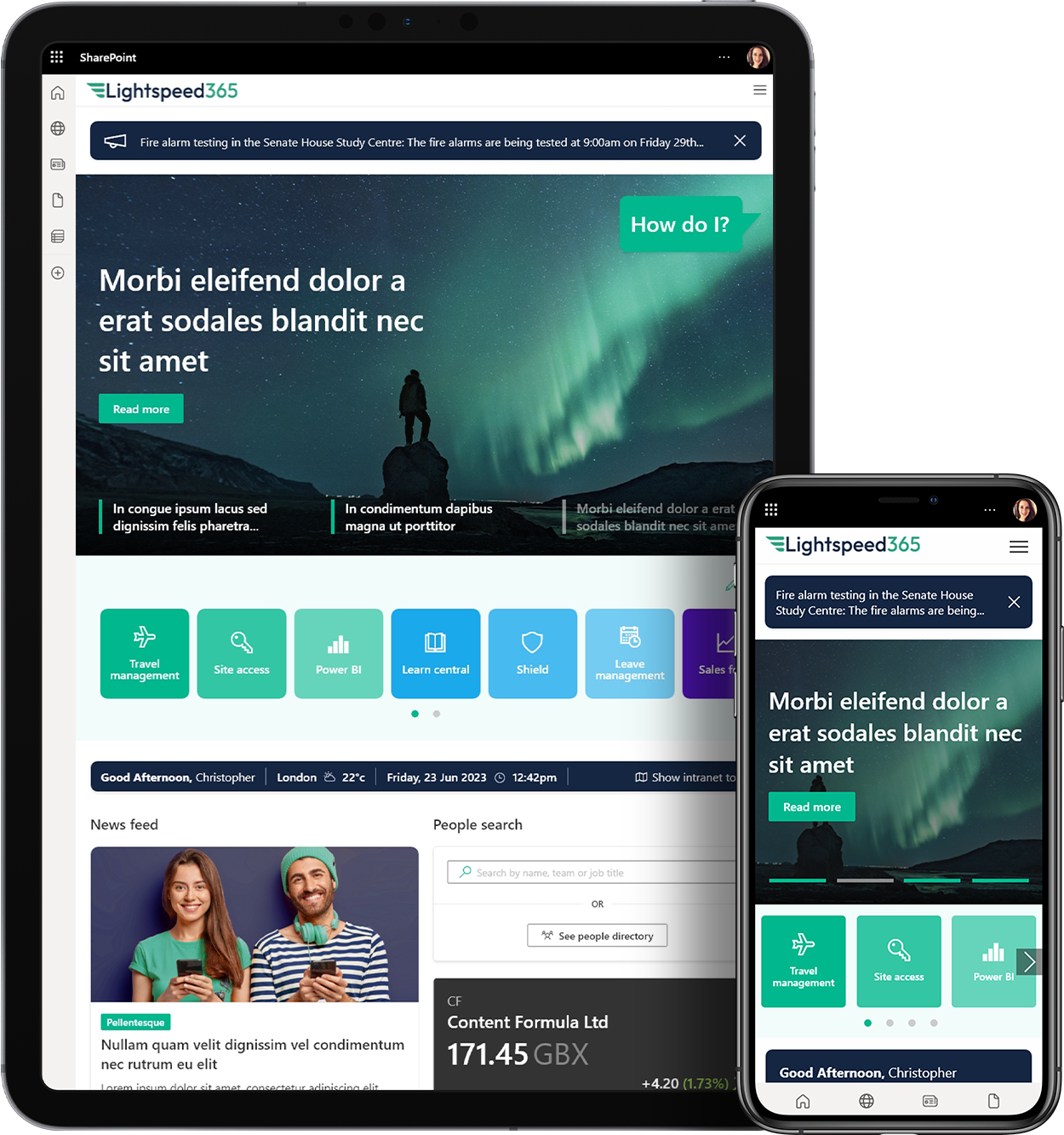What is a modern company intranet and what features does one typically include? Clients regularly ask us this question, particularly when they are considering a new intranet project. In this article, were going to explore the essential features that should be part of a modern company intranet.
The evolution of the intranet
Intranets have been evolving for the past twenty-five years, adding new features, shifting in design and incorporating the influence of external social media. They have transformed from being largely static repositories of content to dynamic front doors into the wider digital workplace, incorporating social and collaborative elements, personalisation, integrations with other applications and more.
This ability to absorb new capabilities and evolve to meet employee needs is one of the reasons intranets are still around today. Occasionally, we read about someone declaring that intranets are dead; this obviously isnt true, as many companies are still choosing to invest in intranets and most have one. What these commentators actually mean is that the old-style intranet solely centred around content is no longer relevant; in fact, they may not class a modern intranet with all its integrations as an intranet at all, but perhaps instead as a digital workplace.
In a sense, it doesnt really matter whether you call an intranet an intranet or not, as long as it delivers value and is well-adopted. In some organisations, branding a new intranet as a digital workplace can help differentiate it from previous intranets and better convey its value; although, in our experience, when many employees see an intranet homepage they will consider it the intranet, however you position it.
Defining the modern company intranet
It can be helpful to define a modern company intranet. Just like the term digital workplace, there is no consensus on an exact definition, but there is a broad understanding of what an intranet is. Company intranet is a private website that helps employees get things done and stay informed. This is quite a high-level definition, but its a suitable umbrella to incorporate the range of features you are likely to find in a modern intranet.
Defining an intranet can be fuzzy in what is technically part of an intranet and what isnt, particularly with the different integrations involved. Naturally, most employees dont realise or even care where an intranet starts and ends, just as long as it is part of the intranet experience. The definition of intranet, then, is more a question for the teams that look after it and carve out responsibilities and governance, although a joined-up approach is always best.
With this in mind, lets look at our view of fifteen essential features you find in a modern intranet. Of course, this doesnt cover everything you might find, but a good intranet should include almost all of the below.
1 A homepage that serves as the entry point to the intranet and wider digital workplace
Intranet homepages play a uniquely important role in the intranet, as they are usually the entry point into intranet content and sometimes the wider digital workplace. A homepage, therefore, needs to aggregate communications, provide links and navigation to the content and systems employees need, and also look engaging and attractive to drive and sustain adoption.
2 Operational, departmental and reference content
In terms of an intranet, content is absolutely king. A good intranet contains operational, departmental and reference material from across the enterprise that helps employees get things done. This evergreen content is often the bedrock of intranet success and does not always get the attention it deserves.
3 A central library of policies, procedures and forms
Another valuable source of essential reference material is usually some kind of central repository or library of policies, procedures and forms that employees can refer to when needed. A central library will have the necessary document management processes to ensure that employees trust they have the very latest version of the policies and forms they need.
4 News and updates
A successful intranet keeps employees informed and engaged. Internal communications is one of the most important elements of an intranet homepage, with personalised news and updates from both central internal comms and across the wider enterprise. For example, in a LiveTiles intranet, a noticeboard feature aggregates news updates from divisional and departmental sites right across the intranet. News and updates keep employees on top of everything they need to know or that may be of interest, from major strategic and operational updates to more engaging and people-focused stories.
5 A global navigation and search
One of the main jobs of an intranet is to help employees find the information they need quickly and effortlessly. Generally, an intranet has two main findability features a search capability and a global navigation. An intranet search may cover just the intranet, but ideally incorporates a wider set of digital channels such as Microsoft 365 applications and even other integrations. There may also be different searches throughout an intranet like a simple search which is available in the header on every page, a more advanced search and perhaps dedicated searches for people and policies.
The global navigation may be delivered through a megamenu or something similar, and there might be a secondary navigation for different areas of an intranet. Findability features in an intranet dont stop here, though there is also potential to browse a people directory or a central directory of apps, both of which are covered below.
6 Personalisation
A key challenge for intranets is ensuring that experiences and content are relevant for every individual. Across a global diverse workforce, this is easier said than done. Personalisation based on employee profiles that targets content based on role, location, region, division, interest and language is a pre-requisite for intranet success. Effective personalisation is dependent on having the right employee profile data, usually delivered through Active Directory.
7 A persistent, personalised toolbar
A growing trend in leading-edge intranets it to have some kind of personalised toolbar that brings together multiple useful elements like aggregated notifications from different systems, critical and favourite links, lists of spaces a person is a member of and updates from collaboration spaces. Often, this toolbar is persistent, so is available from every intranet page; it can also be integrated with the wider digital workplace. One of the best toolbars around is LiveTiles Everywhere, as it is not only experienced though a LiveTiles intranet, but also Teams and other applications across the digital workplace.
8 Integrations and an apps directory
Modern intranets provide a front door into the wider digital workplace. They achieve this in different ways, including direct integrations with other applications such as allowing employees to request annual leave, book a meeting room or log a ticket in ServiceNow. When using SharePoint, there is probably also seamless integration with other Microsoft 365 applications including Yammer and Teams.
Another increasingly popular modern intranet feature is a central directory of enterprise applications that can be posted as shortcuts on the homepage or via a toolbar. This makes the intranet a useful entry point into all the apps employees need to use during the working week.
9 Employee self-service with forms and workflow
Employee self-service means employees can complete simple transactions and tasks themselves, thus saving time for busy support functions such as IT and HR. Intranets enable employees to get things done by supporting self-service in three different ways:
- Integrations that allow for the completion of simple transactions such as booking a holiday
- Forms and workflows that allow employees to submit common requests such as asking for a new laptop
- Finding content that answers common questions.
A successful intranet supports extensive employee self-service, driving efficiency and boosting productivity.
10 Social and community features
Social and community features revolutionised intranets a decade or so ago, and are now a given. Intranets should be dynamic communication platforms, not static one-way content repositories. Employees must be able to comment on and like posts, deliver blogs and updates, contribute to discussions and be part of professional and non-professional communities. Whether these capabilities are built-in to your core intranet or delivered through something like Yammer integration, social features are a must-have intranet feature.
11 Collaboration hub
Collaboration is thriving in most organisations right now, notably through conference software such as Microsoft Teams. Leading intranets usually have some kind of collaboration hub that acts as a central directory of collaboration spaces and provides resources to support collaborative practices. Here, the intranet plays a direct role in driving collaborative adoption and behaviours.
12 Employee directory
Every intranet needs an employee directory that includes profiles of every employee in the organisation, giving contact and role details ideally accompanied by a photo, as well as wider LinkedIn-style information about expertise, interests and more. People search is always one of the most used features of any intranet, and supports good communication, collaboration, and community.
13 Admin interfaces, content templates and analytics
All too often, the experience for content owners and intranet teams gets bypassed; intuitive interfaces and capabilities that support efficient intranet administration and content management are very important features of a modern intranet. When these features work well, they can support the central ownership and devolved publishing model that most modern intranets run on a small team running the intranet from the centre with a wider community of publishers responsible for the majority of intranet content. Important features of this include:
- Administration controls to manage the core elements of the homepage
- Site and content templates which help site owners and content publishers
- Robust intranet analytics dashboards that underpin improvement.
14 Single sign-on
The single biggest barrier to intranet adoption is the requirement for a user to authenticate into an intranet every morning or at each point of need. Single sign-on is an absolutely essential feature of a modern intranet in order to make it effortless for all employees to access the information they need quickly and efficiently. Thankfully, single sign-on through Active Directory or a comparable equivalent is now a feature of the large majority of intranets.
15 Chatbots
Chatbots are not currently a feature in every modern intranet, but we think they are on their way to becoming an essential everyday feature. Conversational interfaces which help employees find information and perform simple transactions are proving their value by supporting self-service, and are thus becoming normalised. They are usually accessible from a personalised toolbar, but also from a page header or footer.
Considering a modern intranet? Get in touch!
We hope you found our list of modern intranet features useful. If you are considering a new intranet and want to discuss any aspects of it, then get in touch!



 SharePoint Products
SharePoint Products

